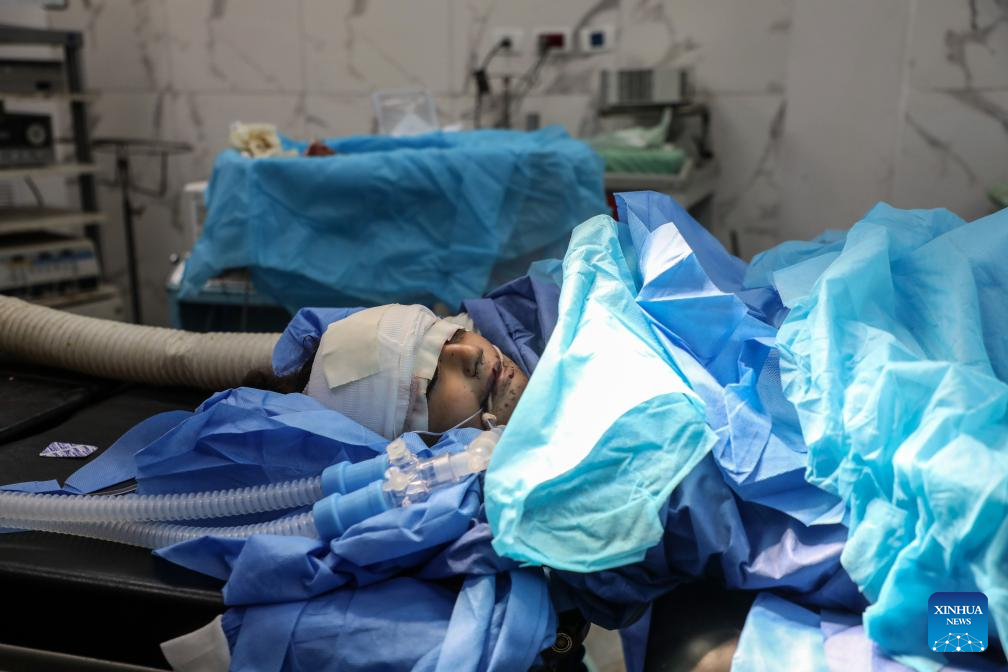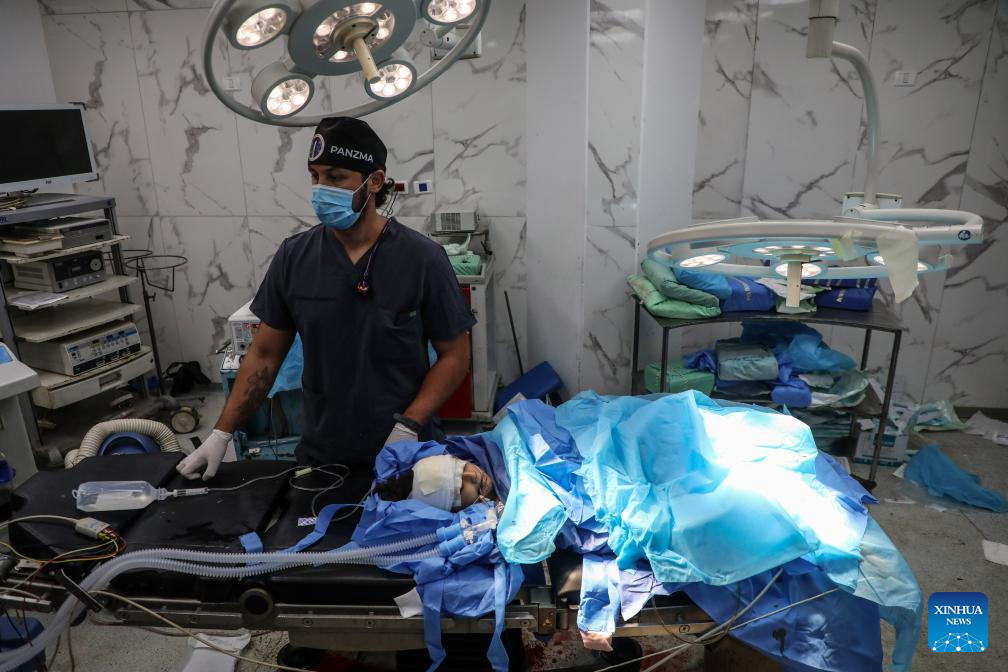Feature: Unexploded ordnance in Gaza poses deadly threat to residents despite ceasefire
Source: Xinhua
Editor: huaxia
2025-10-26 22:58:30

A Palestinian injured child is seen at Al-Shifa Hospital in Gaza City, on Oct. 24, 2025. According to data from the United Nations Mine Action Service (UNMAS), at least 320 Palestinians have been killed and injured by unexploded ordnance across the Gaza Strip since the start of the conflict in October 2023.(Photo by Rizek Abdeljawad/Xinhua)
GAZA, Oct. 26 (Xinhua) -- Six-year-old twins Yahya and Nabila Shorbasi were playing among the rubble of their destroyed home in Gaza City when a sudden explosion shattered the silence of a fragile ceasefire. The small metallic object they had found turned out to be an unexploded bomb.
"We were clearing the rubble when we heard a huge explosion," Abu Mohammed, their grandfather, recalled the horrifying moment.
"We ran and found Yahya and Nabila lying on the ground, covered in blood. They were playing with a round object that exploded the moment they touched it," he said while sitting beside their beds at Al-Shifa Hospital.
Yahya lost his right hand and suffered multiple injuries, while Nabila sustained fractures in her foot. "Playing has become deadly," the grandfather said quietly. "Even after the war ends, we continue to die."
The tragedy of the Shorbasi twins reflects the growing threat of unexploded ordnance (UXO) scattered across the Gaza Strip. Although calm has prevailed since the ceasefire between Israel and Hamas took effect more than two weeks ago, the remnants of war remain buried under debris, turning neighborhoods into potential minefields.
In the northern Gaza City neighborhood of Sheikh Radwan, 10-year-old Ahmed was also injured when a metal object exploded near his family's temporary tent.
"Ahmed thought it was a toy," said his mother, Salwa Hasanat. "I heard the explosion and found him unconscious, his right hand gone. None of us knew these remnants could still kill."
In another case, 13-year-old Samer Bahloul from the Tal al-Hawa area lost his left eye after a small metal box he found near his tent exploded.
"I thought it was something useful," he said quietly. "When I woke up, my father told me I had lost my eye. The doctors said it was part of a bomb."
According to data from the United Nations Mine Action Service (UNMAS), at least 320 Palestinians have been killed and injured by unexploded ordnance across the Gaza Strip since the start of the conflict in October 2023.
The Gaza Center for Human Rights, an independent civil organization monitoring violations, estimates that around 20,000 unexploded bombs and missiles remain scattered across Gaza.
It said that by mid-October, the total rubble resulting from the destruction of homes and vital infrastructure had reached between 65 and 70 million tons, containing about 71,000 tons of explosives and remnants of war.
"Although hostilities have ceased, death remains present in every street and alley of this devastated land. These remnants continue to haunt people even after the end of fighting," Mahmoud Basal, the spokesperson of the civil defense, told Xinhua.
Mohammed, an engineer specializing in ordnance removal and currently working with a local clearance team, said his work has become increasingly dangerous and complex due to shortages of specialized equipment and fuel.
He added that the teams have had to prioritize the most urgent sites, leaving many areas unchecked. "We lack advanced detection devices, heavy machinery, and maintenance parts. Sometimes we work manually, which is much slower but safer for civilians nearby," he said.
The work also takes a heavy toll on the engineers themselves. "The continuous exposure to danger and destruction is exhausting, both physically and mentally," he said. "We have no psychological support or rest periods. But we continue because people's lives depend on our work."
Mohammed explained that clearance operations are coordinated with the United Nations, which has launched community awareness programs to educate residents, especially children, about the dangers of suspicious objects. "The biggest problem is ignorance," he said. "Children see a shiny object and think it's a toy, not realizing it could kill them."
Beyond the human toll, experts warn that unexploded ordnance and other remnants of war are also threatening Gaza's already fragile environment. Environmental engineer Saeed al-Aklouk told Xinhua that the remnants of bombs and missiles are contaminating soil and groundwater across the enclave.
"Thousands of unexploded munitions from the recent Israeli military campaign threaten to deprive farmers of cultivating large areas of land," al-Aklouk said. "These areas have become unsafe for people, animals, and crops alike."
"The destruction of sewage networks has caused the leakage of hazardous substances, while metals and chemicals from the munitions have contaminated farmland," he said. "The long-term environmental and health impacts will be severe."
He warned that cleaning up the remnants of war could take years, delaying recovery and posing lasting dangers to local residents.
"Without international support, advanced equipment, and safe access to affected areas, the task of removing explosive remnants will remain incomplete for a long time," he said. ■

A Palestinian injured child is seen at Al-Shifa Hospital in Gaza City, on Oct. 24, 2025. According to data from the United Nations Mine Action Service (UNMAS), at least 320 Palestinians have been killed and injured by unexploded ordnance across the Gaza Strip since the start of the conflict in October 2023.(Photo by Rizek Abdeljawad/Xinhua)



